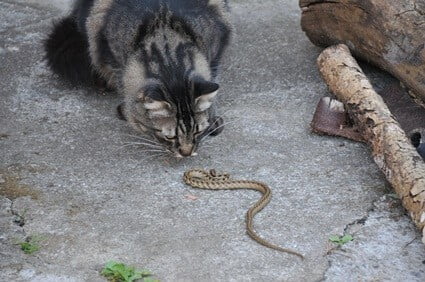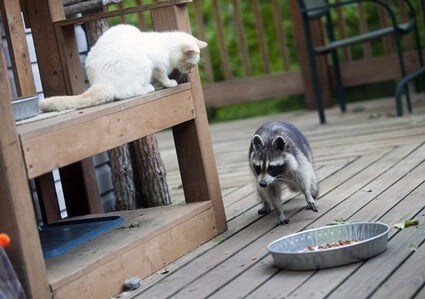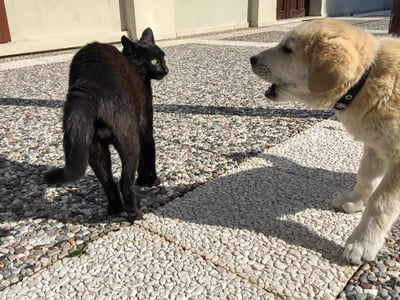Many animals prey upon cats, and even more animals can hurt a cat, perhaps even mortally. Owners that allow their cats to free-roam should be aware of the risks that this entails. Potential predators are a wide and varied list that changes between locations and urban densities.
Large predatory animals that prey on cats include cougars, wolves, and coyotes. Additionally, many small animals, including eagles, snakes (venomous and constrictors), hawks, and owls, hunt cats for food. Also, some dog breeds may pursue cats, but domesticated dogs rarely do so for sustenance.
Not all animal attacks on cats are due to predators seeking food. Some animals act defensively, and these defense mechanisms and behaviors can have painful or even fatal consequences for cats. Venomous creatures, such as snakes, scorpions, and spiders, can bite cats as an act of self-defense.
Do Cats Have Natural Predators?
Predators eat other organisms. The different types of predators are defined by what the predator eats and how it harvests that food. The four main types of predators are carnivorous, herbivorous, parasitic, and mutualistic.
A carnivorous predator must hunt and kill its prey. Carnivorous predators are broken up into two further types: those that primarily scavenge carcasses and those that hunt and kill prey independently.
There are many carnivorous predators, including wolves, cougars, owls, and snakes. Herbivorous predators, like krill, horses, and porcupines, consume autotrophs (plants and algae).
The final two types of predators involve small, sometimes microscopic, organisms living within another animal. For example, flatworms living within a domestic cat.
Mutualism is when this smaller organism lives in harmony with its host and causes no harm. An example is the bacteria that live in the digestive tract. Parasitism can impact or even kill the host, and this means that the parasite deprives the host of essential nutrients to the point where its health declines.
Each of the above types of predators can be further broken down into more detailed and specific categories. For example, insectivores (animals that primarily prey on and eat insects) are a carnivore sub-type. Also, omnivores practice predation on plants and animals.
This predators’ list is primarily made up of strict carnivores.

Snakes
Snakes are found throughout most of America, so encounters with snakes are common. The majority of snake species wouldn’t consider an adult cat to be a food source.
The types of snakes that eat cats include:
Pythons and Boas
Even though pythons are nonvenomous, members of the Pythonidae family still pose a danger to cats.
Any snake that’s large enough to prey upon small mammals will consider cats prey. Many large, nonvenomous snakes in the U.S., such as boa constrictors, started off life as domestic pets.
Also, the Burmese python will prey upon cats. Research published in Biological Invasions notes that Burmese pythons are established in Florida. Encounters with this snake aren’t uncommon, and there are concerns about the snake population spreading beyond the Everglades.
Pythons are ambush predators. A python will lay in wait for a meal to cross its path, and it targets its meal using its strong sense of smell and heat-sensing pits. It will then latch onto its prey before wrapping the animal in its powerful coils.
Constriction can kill a cat in a matter of minutes.
Diamondback Rattlesnakes
A diamondback rattlesnake is the largest venomous snake in the U.S.
There are dozens of reported cases where a cat has been bitten by one of these deadly pit vipers. However, there’s little evidence of rattlesnakes actively preying upon cats. However, eastern and western diamondbacks are large enough to consider smaller cats or juvenile and sub-adult cats prey.
A curious cat may antagonize a rattlesnake, triggering a defensive response. If the snake is hungry and the cat is small enough, the snake may follow the ‘waste not, want not’ principle. Large adult eastern and western diamondbacks will eat fully-grown rabbits, and a small domestic cat is about the same size.
Rattlesnakes are a part of the Viperidae family. As ambush predators, they’ll remain motionless and silent until a prey animal wanders too close. Eastern and western diamondbacks have hemotoxic venom that causes tissue damage and attacks red blood cells.
A cat will quickly succumb to envenomation.
Dogs
Dogs, both feral and domestic, will occasionally prey upon cats.
How an interaction might go between a cat and a dog will depend on their personalities and upbringings. A cat and dog may be completely ambivalent towards one another. Conversely, they may attack one another.
A dog may chase a cat upon sight. This can be out of genuine aggression, territorial instincts, or the desire to play. A cat may also attack on sight, although it’s more likely to puff up in a threat display first.
Aggressive dogs and feral dogs may actively hunt cats.
Coyotes
Coyotes are a part of the Canidae family and are prevalent throughout the U.S.
Coyotes live in packs and alone. The Journal of Wildlife Management found that coyotes actively prey upon cats, especially during the pup-rearing season. Both packs and individuals would successfully attack and kill cats.
Coyotes hunt using their olfactory senses and keen eyesight. Coyotes will hunt in pairs or packs to take down larger prey, such as deer.
Individuals will prey upon smaller animals, such as squirrels, rodents, birds, and even domestic cats. As an opportunistic predator, a coyote will prey upon whatever it comes across.
Wolves
Wolves are the largest surviving member of the Canidae family.
The Journal of Forestry Research noted that wolves were almost driven to extinction through habitat loss and hunting. However, it was recognized that wolves were an essential part of the ecosystem for prey population control.
So, repopulation and conservation efforts were put into place. This included wolves being protected in the U.S. under the Endangered Species Act.
Due to this and human populations encroaching on their natural habitats, wolf-human interactions are becoming more commonplace. This also includes wolf-cat interactions.
Wolves are opportunistic hunters, so they’ll prey upon cats if they have the chance. This is most likely during the colder months when other prey is scarce or while the pack is rearing young pups.
Eagles
A camera was set up to monitor a nest and captured footage of a cat being eaten by a family of bald eagles. Experts have said that eagles preying upon cats is uncommon.
It’s believed that only large eagles have the ability and strength to prey upon cats. The Bureau of Land Management notes that the bald eagle is the second largest bird of prey found in North America.
Eagles hunt during the day and will swoop down and latch onto their prey. This prey consists of fish, birds, small mammals, and rodents.
Large eagles are capable of preying upon cats, but whether they would is uncertain.
Cougar
Cougars, also known as pumas and mountain lions, primarily hunt deer, coyotes, porcupines, elk, and raccoons. Livestock herds are also a temptation for cougars, which is why farmers hunted the species.
Cougars are opportunistic, nocturnal hunters, so hunting will occur between dusk and dawn. Much like the domestic cat, a cougar will stealthily sneak up on its prey. At the right moment, it will lunge and aim a deadly bite for the back of its prey’s neck.
Cougars have been known to prey upon pets, especially those allowed to roam outside at night.
Owls
Large owls can prey upon cats. This includes the great horned owl, which is thought to have the most diverse diet of all raptors. Also, the snowy owl.
Owls hunt from above. One will usually identify its prey while perched at a height, and it’ll then swoop down silently. An owl will latch onto its prey using its sharp talons. Prey is usually killed by being crushed by this powerful grip, trauma caused by the talons, or a quick bite to the neck.
Snowy owls can be found in the northern U.S. when food is scarce. The great horned owl is the largest owl species found in North America. Both prey upon a variety of rodents and larger mammals, including raccoons.
Given that cats are similar in size to raccoons and like to explore when it’s dark, it puts them at risk of being preyed upon by an owl.
Owls can fly silently, so a cat may not know it is being hunted until it’s too late.
Hawks
Of all the hawk species found in the U.S., only the red-tailed hawk is capable of preying upon cats.
The red-tailed hawk is the most common hawk found in the U.S. This raptor hunts small animals, and it won’t distinguish between wild mammals and small cats.
Smaller cats and kittens can be preyed upon by hawks. This isn’t a common occurrence, and reported cases seem to revolve around when pets are left outside unsupervised.
Hawks will seek out prey by using their excellent eyesight. A hawk will coast along in the air and scan the ground for prey. It may also find a comfortable perch and wait for a suitable animal to cross its field of vision.
Wolverines
Although a wolverine may look like a small bear, it belongs to the weasel family. A wolverine will forage upon vegetation and berries, but its diet is primarily meat-based.
Wolverines have been known to attack and subdue prey many times their size. They have also been blamed for missing cats. However, only a small number of missing cat cases are connected to wolverine attacks.
Animals That Can Harm Cats
Even if they don’t actively prey upon cats, many animals will aggressively defend themselves.
If a cat preys upon, tries to play with, or startles one of these animals, it may trigger a fight. Mother animals caring for their young can also fight with ferocity.
Cats
Feral and other free-roaming domestic cats will regularly fight over territory. These fights rarely end with fatal wounds. However, the resulting wounds can fester, which can be fatal if left untreated.
A cat can be very territorial, especially if it isn’t neutered. Mother cats can be extremely aggressive while rearing young, especially towards other cats.
Rats
Historically, cats were used to control rodent populations on farms. Anthrozoös states that there are several cases throughout history of cats being domesticated by farmers in the Old World.
Before thousands of years of selective breeding, cats were quite effective at hunting large rodents, like rats. Most species of domestic cats are smaller than their ancient ancestors.
Rats are large and will fight back if attacked by a cat. A rat’s teeth can inflict damage, and a desperate rat isn’t shy of using them. One bite in the wrong place can puncture an artery. Rats are also carriers of disease and parasites.
Raccoons
Raccoons are common in urban areas, and these pesky animals have learned that there’s an abundance of food to be found where humans live. So, the chances of a free-roaming cat encountering a raccoon are quite high.
A raccoon can overpower an adult cat during territorial disputes or fights over food. As nocturnal mammals, raccoons can cross paths with cats while searching for food. Depending on the abundance or scarcity of food available, the two animals may have a tussle.
As a wild animal, the raccoon may have the natural advantage of lived experiences. A raccoon will usually also have a size and weight advantage over a cat. Larger breeds of cats, such as a male Norwegian forest cat or male Maine coon, are a more even match for a raccoon.
Scorpions
The U.S. is home to various scorpion species. Not all are dangerous, but some are deadly. Scorpions that can be found in the U.S. include:
- Bark scorpions
- Stripe-tailed scorpions
- Arizona hairy scorpions
Of these, only the bark scorpion is considered deadly to humans. A cat is far smaller than a human and will be more affected by scorpion venom. In some cases, envenomation can be lethal. Beyond an allergic reaction, only a sting from a bark scorpion has the potential to be a mortal wound.
Scorpions will use their venom for two purposes: hunting and defense. No scorpion will consider a cat, of any size, as prey. Stings are usually a result of the cat trying to play with or attack the scorpion.
Spiders
Over 3000 species of spiders are known to live in Northern America. Only 3 are considered dangerous: the black widow, the brown recluse, and the hobo spider. These spiders have toxic venom.
Spider bites aren’t always fatal. However, the venom can cause reactions local to the bite, creating internal and open wounds. These wounds are liable to further infection. Spider venom can also cause other symptoms to emerge as the body fights against a toxic substance.
Cats are likely to encounter spiders due to curiosity, investigating the spider or its web.
Foxes
Foxes have adapted to urban environments, increasing the chances of cat-fox interactions. Largely, this comes down to fights. Usually, both participants come off worse for wear, and rarely do the injuries prove fatal.
Foxes are similar in size to adult cats, so foxes will not actively hunt adult cats. The same cannot be said for small kittens. A starving fox may attack an older cat, although we cannot say this for certain. A fox will also aggressively defend its cubs if a cat wanders too close.
Foxes are also scavengers. If one stumbles across a dead cat, it will eat the carcass. It may also drag the carcass to a safer place to eat. All of that said, cats and foxes will usually go their separate ways without fuss.
Porcupines
Porcupines are large rodents, and few predators are willing to risk a face full of those spines. Porcupines have few natural predators. A curious or aggressive cat may make the mistake of approaching a porcupine.
Porcupines are ground and tree-dwelling and found in spots all over the U.S. This animal is not aggressive but will act defensively if approached by what it deems a threat.
A porcupine will swing its tail around at an aggressor, stabbing it with dozens of quills. These quills are tipped with bards, allowing them to pierce flesh and remain lodged within. Although rarely fatal, unless lodged in the throat, porcupine quills cause discomfort.

Venomous Snakes
Beyond diamondbacks, many species of venomous snakes live in the U.S. Any one of these snakes can kill or seriously harm your cat. Just a few of the venomous snakes that can be found in the U.S. include:
- Coral snakes
- Copperhead
- Timber rattlesnake
- Mojave rattlesnake
- Tiger rattlesnake
- Massasauga rattlesnake
The venom of these snakes varies in potency and lethality. If you suspect that a snake has bitten your cat, immediately take it to the vet. Even if you don’t know what kind of snake has bitten it, clinics can offer supportive therapy. They may also have a venom detection kit, which Toxicon notes as being a means of identifying the type of venom inflicted.
Coral Snakes
Not to be confused with the harmless milk snake, coral snakes are highly venomous. Coral snakes can be found throughout North America and are considered one of the most venomous snakes. Powerful neurotoxic venom is delivered through short fangs.
These snakes are slim and small enough that a cat, even a young one, wouldn’t be considered a meal. It will defend itself, though, with a deadly bite. With venom that causes paralysis and respiratory failure, a lack of treatment is a death sentence for a cat.
Copperheads
A common snake in North America with a mild bite, for a pit viper. Copperheads have adapted well to urban living and can commonly be found near human dwellings.
Copperhead bites are usually non-fatal in adult humans, but cats may not be so lucky. A copperhead’s hemotoxic venom causes damage local to the bite area. It has been noted that copperheads inject little venom when biting defensively. Adult cats are too large to be considered a meal.
Rattlesnakes
The U.S. is home to many types of rattlesnakes. All of which are venomous and capable of killing a cat. None but the largest rattlesnakes would consider an adult cat to be prey.
All rattlesnakes will defend themselves if threatened by a cat. Small kittens would be considered a meal. As noted by BMC Genomics, snake venom composition can change not only between species but within species. A population in one area may have purely hemotoxic venom, and a population the next state over may have hemotoxic and neurotoxic venom.
The tiger rattlesnake inhabits a relatively small area between Arizona and Mexico. Due to its highly potent hemotoxic and neurotoxic venom, it is considered the most toxic of all rattlesnakes— one of the most dangerous snakes in the Western Hemisphere.
Massasauga rattlesnakes are smaller rattlesnakes with hemolytic venom. As a shy snake, it avoids humans and settlements as much as possible. Although its venom is quite potent, it injects less venom than other pit vipers per bite.
The Mojave rattlesnake has neurotoxic venom and is one of the world’s most venomous snakes. Undeservedly, this snake is thought to be overly aggressive, but this is untrue. Mojave rattlesnakes act defensively and will strike more enthusiastically than other snakes. This snake lives in the southwestern states and central Mexico.
Timber rattlesnakes have venom that destroys tissue. Depending on the geographic location of the snake, it may have neurotoxic venom, hemotoxic venom, or a combination of the two. This snake can grow quite large, with adults easily reaching 5 feet in length, but its diet comprises of small mammals, birds, frogs, and even other snakes. Small cats may be consumed.
Many animals prey upon cats and many more that can hurt cats. This is a list of predators that will attack cats, alongside animals that your cat’s likely to encounter that could cause harm.


Thanks Rich, great article – fascinating read.